Text and Studies: Contributions to Biblical and Patristic Literature (29 vols.)
Digital Logos Edition
Overview
The early church leaders were prolific in their writing and historical documentation. While some of this work has been canonized, much has been forgotten. The Text and Studies: Contributions to Biblical and Patristic Literature collection resurrects these documents in a renewed and focused study, attempting to glean the wisdom and insight of the ancients. This 29-volume set digs deep into apocryphal literature with critical analyses, close readings, and examinations of the original manuscripts. In the Logos edition, Scripture passages appear on mouse-over, and all cross-references link to the other resources in your digital library, making this collection powerful and easy to access—a cornerstone reference for scholarly work or personal Bible study on patristic literature. Perform comprehensive searches by topic or Scripture reference—finding, for instance, every mention of “martyr” or “Abraham.”
This title is included in the following collections
You can save when you purchase this product as part of a collection.
Logos 8 Reformed Platinum Lega...
$1,499.99$1,499.99Logos 9 Orthodox Platinum Lega...
$1,499.99$1,499.992025 Orthodox Diamond
$2,999.99$2,249.99Logos 8 Anglican Diamond Legac...
$2,999.99$2,999.99
- $2,999.99
- $2,999.99
- $2,999.99
- $2,999.99
- $2,999.99
- $2,999.99
- $4,749.99$3,562.49
- $4,749.99
- $4,749.99
- $4,749.99
- $4,749.99
- $4,749.99
- $4,749.99
- $4,749.99
- $7,749.99
- $7,749.99
- $11,399.99
- $11,399.99
- $23,999.99$17,999.99
- $21,749.99
- $24,999.99

- 29 volumes of in-depth study on patristic and biblical literature
- Content fully networked with your Logos library
- Critical analysis and exegesis of the texts
- Title: Text and Studies: Contributions to Biblical and Patristic Literature (29 vols.)
- University Press
- Volumes: 29
- Pages: 4,912
- Text and Studies: Contributions to Biblical and Patristic Literature, vol. 1, no. 1: The Apology of Aristides on Behalf of the Christians by J. Armitage Robinson, J. Rendel Harris
- Text and Studies: Contributions to Biblical and Patristic Literature, vol. 1, no. 2: The Passion of S. Perpetua by J. Armitage Robinson
- Text and Studies: Contributions to Biblical and Patristic Literature, vol. 1, no. 3: The Lord’s Prayer in the Early Church by Frederic Henry Chase
- Text and Studies: Contributions to Biblical and Patristic Literature, vol. 1, no. 4: The Fragments of Heracleon by A. E. Brooke
- Text and Studies: Contributions to Biblical and Patristic Literature, vol. 2, no. 1: A Study of Codex Bezae by J. Rendel Harris
- Text and Studies: Contributions to Biblical and Patristic Literature, vol. 2, no. 2: The Testament of Abraham by Montague Rhodes James, W. E. Barnes
- Text and Studies: Contributions to Biblical and Patristic Literature, vol. 2, no. 3: Apocrypha Anecdota by Montague Rhodes James
- Text and Studies: Contributions to Biblical and Patristic Literature, vol. 3, no. 1: The Rules of Tyconius by F. C. Burkitt
- Text and Studies: Contributions to Biblical and Patristic Literature, vol. 3, no. 2: The Fourth Book of Ezra by Robert L. Bensly
- Text and Studies: Contributions to Biblical and Patristic Literature, vol. 3, no. 3: Euthaliana by J. Armitage Robinson
- Text and Studies: Contributions to Biblical and Patristic Literature, vol. 4, no. 1: The Athanasian Creed and Its Early Commentaries by A. E. Burn
- Text and Studies: Contributions to Biblical and Patristic Literature, vol. 4, no. 2: Coptic Apocryphal Gospels by Forbes Robinson
- Text and Studies: Contributions to Biblical and Patristic Literature, vol. 4, no. 3: The Old Latin and the Itala by F. C. Burkitt
- Text and Studies: Contributions to Biblical and Patristic Literature, vol. 5, no. 1: Apocrypha Anecdota, Second Series by Montague Rhodes James
- Text and Studies: Contributions to Biblical and Patristic Literature, vol. 5, no. 2: Clement of Alexandria: Quis Dives Salvetur by P. Mordaunt Barnard
- Text and Studies: Contributions to Biblical and Patristic Literature, vol. 5, no. 3: The Hymn of the Soul Contained in the Syriac Acts of St. Thomas by Anthony Ashley Bevan
- Text and Studies: Contributions to Biblical and Patristic Literature, vol. 5, no. 4: Codex Purpureus Petropolitanus: The Text of Codex N of the Gospels Edited with an Introduction and an Appendix by H. S. Cronin
- Text and Studies: Contributions to Biblical and Patristic Literature, vol. 5, no. 5: The Biblical Text of Clement of Alexandria P. Mordaunt Barnard and F. C. Burkitt
- Text and Studies: Contributions to Biblical and Patristic Literature, vol. 6, no. 1: The Lausiac History of Palladius by Cuthbert Butler
- Text and Studies: Contributions to Biblical and Patristic Literature, vol. 6, no. 2: The Lausiac History of Palladius, vol. 2 by Cuthbert Butler
- Text and Studies: Contributions to Biblical and Patristic Literature, vol. 7, no. 1: The Meaning of Homoousios in the 'Constantinopolitan' Creed by J. F. Bethune-Baker
- Text and Studies: Contributions to Biblical and Patristic Literature, vol. 7, no. 2: S. Ephraim's Quotations from the Gospel by F. C. Burkitt
- Text and Studies: Contributions to Biblical and Patristic Literature, vol. 7, no. 3: Codex 1 of the Gospels and Its Allies by Kirsopp Lake
- Text and Studies: Contributions to Biblical and Patristic Literature, vol. 7, no. 4: A Study of Ambrosiaster by Alexander Souter
- Text and Studies: Contributions to Biblical and Patristic Literature, vol. 8, no. 1: The Liturgical Homilies of Narsai by R. H. Connolly, Edmund Bishop
- Text and Studies: Contributions to Biblical and Patristic Literature, vol. 8, no. 2: The Mishna on Idolatry 'Aboda Zara by W. A. L. Elmslie
- Text and Studies: Contributions to Biblical and Patristic Literature, vol. 8, no. 3: The Odes of Solomon J. H. Bernard
- Text and Studies: Contributions to Biblical and Patristic Literature, vol. 8, no. 4: The So-Called Egyptian Church Order and Derived Documents by R. H. Connolly
- Text and Studies: Contributions to Biblical and Patristic Literature, vol. 9, no. 1: Pelagius’s Expositions of Thirteen Epistles of St. Paul: Introduction by Alexander Souter
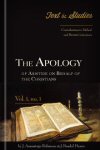
Text and Studies: Contributions to Biblical and Patristic Literature, vol. 1, no. 1: The Apology of Aristides on Behalf of the Christians
- Authors: J. Armitage Robinson, J. Rendel Harris
- Series: Text and Studies: Contributions to Biblical and Patristic Literature
- Publisher: University Press
- Publication Date: 1891
- Pages: 171
“The Apology of Aristides on Behalf of the Christians” is one of the earliest apologetic cases made on behalf of Christians to the Roman Emperors. This translation of the Syriac version was made from texts preserved in the library of the convent of Saint Catherine on Mount Sinai.
J. Rendel Harris, was a former fellow of Clare College, Cambridge and a professor of biblical languages in Haverford College, Pennsylvania.
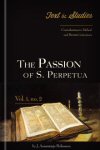
Text and Studies: Contributions to Biblical and Patristic Literature, vol. 1, no. 2: The Passion of S. Perpetua
- Author: J. Armitage Robinson
- Series: Text and Studies: Contributions to Biblical and Patristic Literature
- Publisher: University Press
- Publication Date: 1891
- Pages: 131
The Passion of S. Perpetua recounts the third-century martyrdom of Perpetua, a Roman noblewoman who refused to recant her faith and was executed for her beliefs in the Roman arena. Robinson provides the original Latin text, with a new edition of the manuscript, introduction, and notes.
J. Armitage Robinson was a fellow and assistant tutor at Christ’s College in Cambridge.
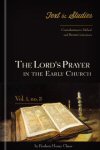
Text and Studies: Contributions to Biblical and Patristic Literature, vol. 1, no. 3: The Lord’s Prayer in the Early Church
- Author: Frederic Henry Chase
- Series: Text and Studies: Contributions to Biblical and Patristic Literature
- Publisher: University Press
- Publication Date: 1891
- Pages: 179
Frederic Henry Chase provides a line-by-line exposition and textual criticism of the Lord’s prayer. He includes an introduction and overview of the history and place of the church, synagogues, and Hellenistic synagogues.
Frederic Henry Chase was principal of the clergy training school in Cambridge.
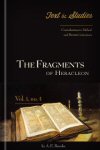
Text and Studies: Contributions to Biblical and Patristic Literature, vol. 1, no. 4: The Fragments of Heracleon
- Author: A. E. Brooke
- Series: Text and Studies: Contributions to Biblical and Patristic Literature
- Publisher: University Press
- Publication Date: 1891
- Pages: 112
This study examines The Fragments of Heracleon. Heracleon, a Gnostic from the school of Valentinius, is the earliest commentator on the New Testament known to date, and is quoted nearly 50 times by Origen in his commentary on St. John. A. E. Brooke offers an introduction to the manuscripts, a brief life and teaching of Heracleon, and the original Greek text of the extant fragments of Heracleon’s translation, fully annotated.
A. E. Brooke was a fellow of King’s College in Cambridge.
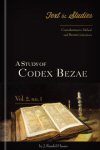
Text and Studies: Contributions to Biblical and Patristic Literature, vol. 2, no. 1: A Study of Codex Bezae
- Author: J. Rendel Harris
- Series: Text and Studies: Contributions to Biblical and Patristic Literature
- Publisher: University Press
- Publication Date: 1891
- Pages: 202
The Codex Bezae is a fifth-century text that was handwritten on vellum. It collects, in both Greek and Latin, most of the four Gospels, the book of Acts, and a small fragment of the John 3. In this study, J. Rendel Harris examines the Codex Bezae in an attempt to solve “textual enigmas which recur so constantly in its pages.” He provides a life-history of the text and criticism of both it and its usage in New Testament scholarship.
J. Rendel Harris was a former fellow of Clare College, Cambridge, and a professor of biblical languages in Haverford College, Pennsylvania.
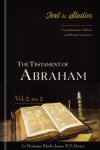
Text and Studies: Contributions to Biblical and Patristic Literature, vol. 2, no.2: The Testament of Abraham
- Authors: Montague Rhodes James, W. E. Barnes
- Series: Text and Studies: Contributions to Biblical and Patristic Literature
- Publisher: University Press
- Publication Date: 1892
- Pages: 166
The Testament of Abraham, a pseudepigraphic (or falsely attributed) work, is thought to have been written by a Jewish Christian in the first or second century. It deals with Abraham’s death — both his reluctance to enter into the death, and the manner in which he died. Montague Rhodes James provides an introductory history of this apocalyptic book, its influence on later literature and how it fits into other Jewish and Christian literature. Both the short and long recenscions of the text are included.
Montague Rhodes James was a fellow dean and divinity lecturer of King’s College and assistant director of the Fitzwilliam Museum.
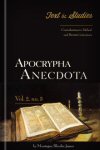
Text and Studies: Contributions to Biblical and Patristic Literature, vol. 2, no. 3: Apocrypha Anecdota
- Author: Montague Rhodes James
- Series: Text and Studies: Contributions to Biblical and Patristic Literature
- Publisher: University Press
- Publication Date: 1893
- Pages: 202
Montague Rhodes James collates the Greek, Syriac, and Latin texts (when available) of apocryphal literature. He provides introductions, commentary, and annotations for each, exploring the Oriental and Slavonic literature. His work extends to eight apocryphal fragments, including The Description of the Antichrist, The Apocalypse of Peter, The Apocalypse of Adam, and The Book of Enoch.
Montague Rhodes James was a fellow dean and divinity lecturer of King’s College and assistant director of the Fitzwilliam Museum.
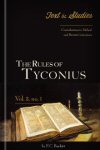
Text and Studies: Contributions to Biblical and Patristic Literature, vol. 3, no. 1: The Rules of Tyconius
- Author: F. C. Burkitt
- Series: Text and Studies: Contributions to Biblical and Patristic Literature
- Publisher: University Press
- Publication Date: 1894
- Pages: 379
Tyconius was a fourth-century African Donatist writer. His writings and thoughts on the City of God influenced St. Augustine of Hippo. The Rules of Tyconius provides a textual criticism of the Latin versions of this pre-Augustinian African writer’s works. It includes the writings of Tyconius, dating analysis, and a literary history.
F. C. Burkitt (1864–1935) was a British theologian and scholar.
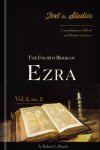
Text and Studies: Contributions to Biblical and Patristic Literature, vol. 3, no. 2: The Fourth Book of Ezra
- Author: Robert L. Bensly
- Series: Text and Studies: Contributions to Biblical and Patristic Literature
- Publisher: University Press
- Publication Date: 1895
- Pages: 202
This textual study of the Latin version of the Fourth Book of Ezra, as edited by Robert L. Bensly includes a thorough introduction by Montague Rhodes James. His introduction provides an overview of the manuscripts, an examination of multiple versions, and an inquiry into the name of the book. Appendixes and indexes round out the content, making it a vital study aid on this apocryphal work.
Robert L. Bensly was the Lord Almoner’s Professor of Arabic at the University of Cambridge.
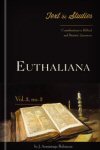
Text and Studies: Contributions to Biblical and Patristic Literature, vol. 3, no. 3: Euthaliana
- Author: J. Armitage Robinson
- Series: Text and Studies: Contributions to Biblical and Patristic Literature
- Publisher: University Press
- Publication Date: 1895
- Pages: 134
Euthalius, a deacon of Alexandria and later the bishop of Sulca, is thought to have lived during the fifth century, and is primarily known for his work on the New Testament. This volume by J. Armitage Robinson provides an in-depth study of the works of Euthalius and Codex H of the Pauline Epistles, as well as a look at the Armenian version of the text.
J. Armitage Robinson was a fellow and assistant tutor of at Christ’s College in Cambridge.
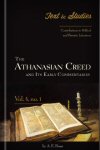
Text and Studies: Contributions to Biblical and Patristic Literature, vol. 4, no. 1: The Athanasian Creed and Its Early Commentaries
- Author: A. E. Burn
- Series: Text and Studies: Contributions to Biblical and Patristic Literature
- Publisher: University Press
- Publication Date: 1896
- Pages: 172
The Athanasian Creed, a Christian statement of belief that focuses on Trinitarian Doctrine and Christology, was the first to explicitly state the equality of the three persons of the Trinity. It differs from the Apostles’ Creed in that it condemns those who disagree with its precepts. In this volume, A. E. Burn examines the creed and its early commentaries, providing his own observations through annotations and critical notes.
A. E. Burn was the rector of Kynnersley Wellington Salop.
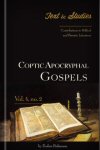
Text and Studies: Contributions to Biblical and Patristic Literature, vol. 4, no. 2: Coptic Apocryphal Gospels
- Author: Forbes Robinson
- Series: Text and Studies: Contributions to Biblical and Patristic Literature
- Publisher: University Press
- Publication Date: 1896
- Pages: 264
Forbes Robinson offers an introduction to and examination of the Coptic Apocryphal Gospels. He examines the importance of the apocryphal literature in relation to the canon, providing copious notes and annotations on the texts.
Forbes Robinson was a lecturer in theology at Christ’s College, Cambridge.
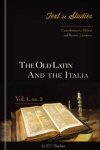
Text and Studies: Contributions to Biblical and Patristic Literature, vol. 4, no. 3: The Old Latin and the Itala
- Author: F. C. Burkitt
- Series: Text and Studies: Contributions to Biblical and Patristic Literature
- Publisher: University Press
- Publication Date: 1896
- Pages: 96
In this series of essays, birthed from F. C. Burkitt’s lecture delivered at Oxford, he calls attention to points of interest in the Latin versions of the Bible, exploring general problems in the texts. Burkitt addresses the identification of the St. Augustine’s Itala with the Vulgate. He provides in-depth notes, appendixes, and annotations to further define and enhance his study
F. C. Burkitt (1864–1935) was a British theologian and scholar.
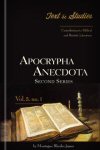
Text and Studies: Contributions to Biblical and Patristic Literature, vol. 5, no. 1: Apochypha Anecdota, Second Series
- Author: Montague Rhodes James
- Series: Text and Studies: Contributions to Biblical and Patristic Literature
- Publisher: University Press
- Publication Date: 1896
- Pages: 174
James examines this second collection of apocryphal texts, covering The Acts of Andrew, the Letters of Herod and Pilate, and the Letter of Tiberius to Pilate. He provides introductions and overviews of the text, as well as textual criticism and notations to further engage and enhance your study of these para-Scriptures.
Montague Rhodes James was a fellow dean and divinity lecturer of King’s College and assistant director of the Fitzwilliam Museum.
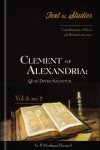
Text and Studies: Contributions to Biblical and Patristic Literature, vol. 5, no. 2: Clement of Alexandria: Quis Dives Salvetur
- Author: P. Mordaunt Barnard
- Series: Text and Studies: Contributions to Biblical and Patristic Literature
- Publisher: University Press
- Publication Date: 1897
- Pages: 66
Quis Dives Salvetur, or “Who among the Rich Might Be Saved” is Clement of Alexandria’s text reflecting on Christ’s command to the rich man to let go of his property and possessions and take up the call. In this volume, Barnard provides a textual criticism, observations, notes, and an appendix on Clementine fragments.
P. Mordaunt Barnard attended Christ’s College Cambridge.
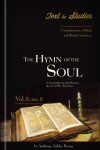
Text and Studies: Contributions to Biblical and Patristic Literature, vol. 5, no. 3: The Hymn of the Soul Contained in the Syriac Acts of St. Thomas
- Author: Anthony Ashley Bevan
- Series: Text and Studies: Contributions to Biblical and Patristic Literature
- Publisher: University Press
- Publication Date: 1897
- Pages: 40
The Hymn of the Soul, also known as The Hymn of the Pearl is a Syriac poem popular in early church mainstream Christian circles. Anthony Ashley Bevan offers an introductory overview to this hymn alongside the original text and its English translation. He provides a history of the manuscript and commentary on the work.
Anthony Ashley Bevan was a fellow of Trinity College Cambridge and the Lord Almoner’s Reader in Arabic.
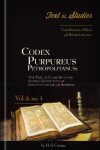
Text and Studies: Contributions to Biblical and Patristic Literature, vol. 5, no. 4: Codex Purpureus Petropolitanus: The Text of Codex N of the Gospels Edited with an Introduction and an Appendix
- Author: H. S. Cronin
- Series: Text and Studies: Contributions to Biblical and Patristic Literature
- Publisher: University Press
- Publication Date: 1899
- Pages: 108
H. S. Cronin discusses the history of the manuscript and its fragments, carefully analyzing internal sources for dating. Cronin compares Codex N with Codex Σ, and offers a reconstruction and description of the manuscript in its entirety, examining the character of the text and providing commentary and analysis.
H. S. Cronin was dean of Trinity Hall in Cambridge.
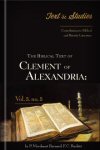
Text and Studies: Contributions to Biblical and Patristic Literature, vol. 5, no. 5: The Biblical Text of Clement of Alexandria
- Authors: P. Mordaunt Barnard, F. C. Burkitt
- Series: Text and Studies: Contributions to Biblical and Patristic Literature
- Publisher: University Press
- Publication Date: 1899
- Pages: 64
P. Mordaunt Barnard makes Clement of Alexandria’s texts of the Gospels and Acts accessible in a single volume. Providing footnotes, he calls attention to evidence that will help elucidate reading of these texts, and provides abundant notes and commentary to further expound on the texts.
P. Mordaunt Barnard (1868–1941) was a reverend from Royal Turnbridge Wells, Kent. He attended Christ’s College in Cambridge.
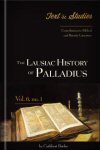
Text and Studies: Contributions to Biblical and Patristic Literature, vol. 6, no. 1: The Lausiac History of Palladius
- Author: Cuthbert Butler
- Series: Text and Studies: Contributions to Biblical and Patristic Literature
- Publisher: University Press
- Publication Date: 1904
- Pages: 258
This critical discussion focuses on the work of Palladius of Galatia, a bishop of Helenopolis in Bithynia. A devoted disciple of St. John Chrysostom, Palladius’ seminal work, The Lausiac History, is a fifth-century archive of the Desert Fathers. Volume one provides textual criticism of The Lausiac History; an examination of the relationships between the texts; Syriac, Armenian, Coptic, Ethiopic and Arabic versions of the text; and historical criticism.
Cuthbert Butler was a Benedictine monk of the English congregation and of Downside Monastery.
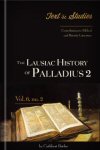
Text and Studies: Contributions to Biblical and Patristic Literature, vol. 6, no. 2: The Lausiac History of Palladius 2
- Author: Cuthbert Butler
- Series: Text and Studies: Contributions to Biblical and Patristic Literature
- Publisher: University Press
- Publication Date: 1904
- Pages: 278
This critical discussion focuses on the work of Palladius of Galatia, a bishop of Helenopolis in Bithynia. A devoted disciple of St. John Chrysostom, Palladius’ seminal work, The Lausiac History, is fifth-century archive of the Desert Fathers. Volume two provides an overview of the methods used to edit the document, a history of the text, examination of different versions, and critical opinions on Early Egyptian Monachism.
Cuthbert Butler was a Benedictine monk of the English congregation and of Downside Monastery.
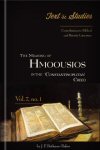
Text and Studies: Contributions to Biblical and Patristic Literature, vol. 7, no. 1: The Meaning of Homoousios in the ‘Constantinopolitan’ Creed
- Author: J. F. Bethune-Baker
- Series: Text and Studies: Contributions to Biblical and Patristic Literature
- Publisher: University Press
- Publication Date: 1901
- Pages: 83
Homoousious, which means “the same substance” is a technical theological term used in discussion of the Christian understanding of God as Trinity. This volume examines the metamorphosis of this denotation in the Constantinoplitan Creed, and its impact on the Christian church.
J. F. Bethune-Baker was a fellow and dean of Pembroke College, Cambridge
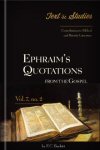
Text and Studies: Contributions to Biblical and Patristic Literature, vol. 7, no. 2: S. Ephraim’s Quotations from the Gospel
- Author: F. C. Burkitt
- Series: Text and Studies: Contributions to Biblical and Patristic Literature
- Publisher: University Press
- Publication Date: 1901
- Pages: 83
St. Ephraim was a Syriac deacon and prolific fourth-century theologian. This book attempts to determine what text of the Gospels was used in the genuine works of St. Ephraim and investigates the influence the Peshitta had on his quotations of the Gospels.
F. C. Burkitt (1864–1935) was a British theologian and scholar.
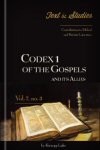
Text and Studies: Contributions to Biblical and Patristic Literature, vol. 7, no. 3: Codex 1 of the Gospels and Its Allies
- Author: Kirsopp Lake
- Series: Text and Studies: Contributions to Biblical and Patristic Literature
- Publisher: University Press
- Publication Date: 1902
- Pages: 91
This volume provides a look at a collation of miniscule manuscripts that augment the Gospels. Kirsopp Lake examines the relationships between these codexes and provides a description and history of the manuscripts in an attempt to reconstruct the archetype.
Kirsopp Lake attended Lincoln College and was the Oxford curate of St Mary the Virgin in Oxford.
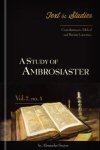
Text and Studies: Contributions to Biblical and Patristic Literature, vol. 7, no. 4: A Study of Ambrosiaster
- Author: Alexander Souter
- Series: Text and Studies: Contributions to Biblical and Patristic Literature
- Publisher: University Press
- Publication Date: 1905
- Pages: 267
This volume examines a series of commentaries on Paul’s thirteen epistles which have been erroneously attributed to Saint Ambrose. These commentaries, now labeled under the name of ‘Ambrosiaster,’ present a clear and concise interpretation and analysis of the letters. Alexander Souter’s study provides an in-depth look at the history of the commentaries, their authorship, and the general character of the commentary.
Alexander Souter was the Yates Professor of New Testament Greek and exegesis at Mansfield College, Oxford
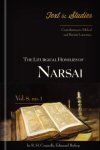
Text and Studies: Contributions to Biblical and Patristic Literature, vol. 8, no. 1: The Liturgical Homilies of Narsai
- Authors: R. H. Connolly, Edmund Bishop
- Series: Text and Studies: Contributions to Biblical and Patristic Literature
- Publisher: University Press
- Publication Date: 1909
- Pages: 176
In the Liturgical Homilies of Narsai, R. H. Connolly examines four metrical discourses, or homilies, written in Syriac by what is thought to be Narsai, one of the foremost Syriac poet-theologians. Narsai has been called the most important writer of the Church of the East, and his homilies have had a marked influence on liturgy throughout the church.
R. H. Connolly (1873–1948) was a British theologian.
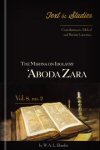
Text and Studies: Contributions to Biblical and Patristic Literature, vol. 8, no. 2: The Mishna on Idolatry 'Aboda Zara
- Author: W. A. L. Elmslie
- Series: Text and Studies: Contributions to Biblical and Patristic Literature
- Publisher: University Press
- Publication Date: 1911
- Pages: 136
The Mishna on Idolatry is a Jewish document that gives readers valuable insights into the development of Jewish religion during the first centuries. It records the decisions which are the “crystallized result of discussion in the Rabbinical schools”, and examines the state of relations between Jews and Gentiles
W. A. L. Elmslie was a fellow of Christ’s College.
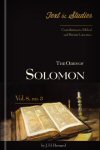
Text and Studies: Contributions to Biblical and Patristic Literature, vol. 8, no. 3: The Odes of Solomon
- Author: J. H. Bernard
- Series: Text and Studies: Contributions to Biblical and Patristic Literature
- Publisher: University Press
- Publication Date: 1912
- Pages: 121
The remains of second-century Christian literature which have survived the ages are scanty at best, and few merit the term “literature”. The Odes of Solomon is a rare example of literary excellence that has survived the passage of time. J. H. Bernard examines the Odes to discover the habits of religious life and thought in the patristic church, interpreting the passages with an interest in critical analysis.
J. H. Bernard was the bishop of Ossory, Ferns and Leighlin.
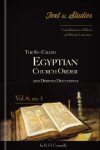
Text and Studies: Contributions to Biblical and Patristic Literature, vol. 8, no. 4: The So-Called Egyptian Church Order and Derived Documents
- Author: R. H. Connolly
- Series: Text and Studies: Contributions to Biblical and Patristic Literature
- Publisher: University Press
- Publication Date: 1916
- Pages: 197
R. H. Connolly explores the Egyptian church order, providing a thorough introduction to the five documents derived from this sect, and and investigation into the texts. His work provides clarity and insight to what is often known as the “lost” church order.
R. H. Connolly(1873–1948) was a British theologian.
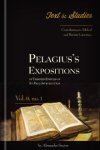
Text and Studies: Contributions to Biblical and Patristic Literature, vol. 9, no. 1: Pelagius's Expositions of Thirteen Epistles of St. Paul: Introduction
- Author: Alexander Souter
- Series: Text and Studies: Contributions to Biblical and Patristic Literature
- Publisher: University Press
- Publication Date: 1922
- Pages: 360
Alexander Souter provides a textual reconstruction of archetypical authorities such as Psuedo-Jerome and Pseudo-Primasius and examines the character and nature of Pelagius’ text. Souter’s work gives an overview of Pelagius, his commentary, and summaries of previous research.
Alexander Souter was the Regius professor of humanity and lecturer in medieval paleography in the University of Aberdeen.
Reviews
4 ratings

Eugene
9/2/2017
AeliusCicero
10/22/2014

Larry Proffitt (I
7/3/2014